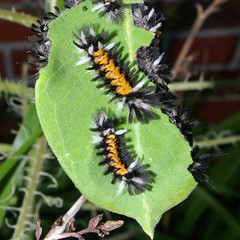 Lucy saw some cool caterpillars on her walk and came back to get the boys and me so we could see them too. There were three or four milkweed plants near one corner of a building that had been denuded and the two in the shade were still covered with caterpillars.
Lucy saw some cool caterpillars on her walk and came back to get the boys and me so we could see them too. There were three or four milkweed plants near one corner of a building that had been denuded and the two in the shade were still covered with caterpillars.
I took my new camera and tripod so I could practice trying to get some close ups. Unfortunately, they were in a somewhat shady spot, so I didn't try to use my extension tubes, but I thought the pictures came out pretty well.
There were at least a hundred on the plant I photographed. Most of them are on the undersides of the leaves. I took a couple of shots a foot away and then moved to within 6 inches. After I took the shot, I must have breathed on them or something, because almost all of them let go at once and rained down into the weeds below. They must have some kind of signaling mechanism.
I looked them up and decided they must be Euchaetes egle, the Milkweed Tussock Caterpillar. I was reluctant to touch them, since they look like they might have urticating hairs, but I couldn't find any evidence of that in the online references. Daniel brought back a couple with a bunch of milkweed leaves in hopes that they'll spin a coccoon and he can see them emerge. Unfortunately, there probably won't be enough time before we have to leave for St. Croix.
In fact, it turns out that Tussock Moths (Lymantridae) are known for having urticating hairs! I thought about linking to the wikipedia page on urticating hairs and found that it only talked about them on tarantulas, so I did some more searching and found that, yes, caterpillars do have urticating hairs and that Euchaetes are known to have them. So I took a half-hour and updated the wikipedia page. Nifty!
- Steven D. Brewer's blog
- Log in to post comments
